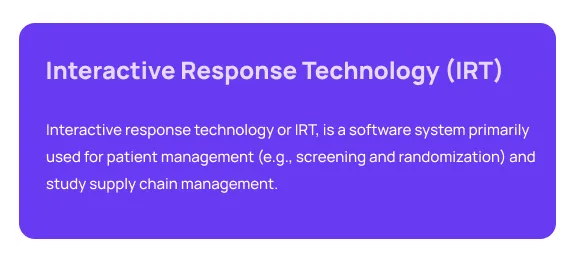Your session is about to expire
What is Interactive Response Technology (IRT): A Comprehensive Guide
Interactive response technology or IRT, is a software system primarily used for patient management (e.g., screening and randomization) and study supply chain management. An IRT system helps bring patients into the trial, and it ensures that the required supplies (e.g., drugs) reach the right place at the right time. Utilizing IRT in clinical trials helps optimize and streamline clinical trial operations.
This article will cover the following topics:
- What does IRT mean in clinical trials?
- How is Interactive Response Technology used in clinical trials?
- What is the difference between IRT and IVRS?
- What are the benefits of an Interactive Response Technology system?
- IRT explained in 3 bullet points

Interactive Response Technology explained: What does IRT mean in clinical trials?
Interactive Response Technology (IRT) definition
IRT stands for interactive response technology, and it is used for trial randomization and supply chain management. It helps clinical trial sponsors manage the drug supply and patient logistics throughout a clinical trial. It also helps in real-time drug and data allocation, ensuring patients receive the right drug or placebo and managing patient schedules throughout a clinical trial, thus offering a cost-effective solution to different clinical trial challenges. Sometimes these systems are also referred to as Randomization and Trial Supply Management systems, or RTSM.
How is Interactive Response Technology used in clinical trials?
Patient Logistics: Randomizing patients and managing treatments
A primary function of IRT in clinical trials is patient randomization. In a blinded trial, IRT helps assign patients to random trial groups or treatment arms based on different factors through screening. It helps keep a trial blinded, reduces bias, and creates an even enrollment distribution. The treatment arms are pre-defined in the protocol and can range in number depending on the study design.
Once the patient has completed screening, an IRT system will assign the patient to the appropriate treatment arm based on the defined methodology for randomization. The IRT can also assign the appropriate drugs for this patient according to the randomized treatment arm.
Trial Supply Management: Getting supplies to the clinical trial site
Another essential function of IRT is to get the right drug to the right patient at the right time. Many phase II and phase III clinical trials face logistical challenges, such as not having the drug available on site at the time of the patient’s visit or inventory over/understocking due to a lack of supply forecasting tools that can help make intelligent and quantitative analyses. Here is where an IRT system is helpful.
The data generated supports drug supply management by knowing the patient’s treatment group and the expected dispensation schedule. Drug disposition can be reviewed through an interactive response technology system, which can help clinical operations teams make informed decisions for additional supply needs.
What is the difference between IRT and IVRS?
IRT is an umbrella term used to describe interactive response technology systems.
IVRS stands for interactive voice response systems, which are a type of IRT system that use telephones to allow study administrators and investigators to interact with a computer database by calling patients and asking them about their progress throughout a clinical trial, including aspects such as drugs received, any symptoms experienced, etc.
The IVRS functionality is generally being replaced by Interactive Web Response Systems (IWRS), which are a newer type of IRT wherein users utilize computer prompts to interact with a database in order to enter study information.
What are the benefits of an Interactive Response Technology system?
Reduces trial supply costs
IRT is useful in clinical supply chain management and for timely logistics, and offers a management solution that reduces supply costs. As discussed above, one of the pain points clinical investigators commonly encounter is the unavailability of medication at the time of the patient’s visit due to a lack of accurate supply forecasting.
An IRT system helps reduce trial supply costs by gathering real-time data and making informed decisions about inventory. An IRT's real-time data and analytical capabilities improve decision-making, and the predictive resupply algorithms automate and optimize drug supply.
Accelerates both study start-up and trial decision-making
An IRT system can be used to implement trial workflows in a few steps. The underlying design, randomization pattern, and drug distribution needs can be similar across clinical trials, so sponsors can speed up decision-making around trial requirements, documentation, and user acceptability testing (UAT) and can choose pre-validated elements available in an IRT to get their study started up as quickly as possible.
Moreover, access to real-time predictive and analytical data improves trial decision-making and ensures that the right drug reaches the right patient at the right time.
Improves operational excellence
IRT supports critical components of trial management. From patient enrollment to drug allocation, IRTs help in randomization and ensure no dispensation delays occur. It improves operational excellence by seamlessly integrating with other clinical systems and cutting down on manual tasks such as data entry, reducing the risk of data inconsistency.
IRT explained in 3 bullet points
- What it is: In clinical trials, IRT stands for interactive response technology. It is a comprehensive solution focusing on patient randomization and optimized drug supply chain management. IRT automates several complex trial tasks and streamlines logistical requirements to reduce errors and delays.
- How it’s used: An IRT system uses real-time data and analysis to make improved forecasting decisions. With an IRT system, you can optimize drug distribution, assign patients to treatment arms, check the effectiveness of a drug against a specific treatment arm, and reduce errors.
- Why it’s used: IRT allows clinical researchers to accurately randomize patients, make informed decisions, reduce decision-making time, and make accurate inventory and treatment analyses.